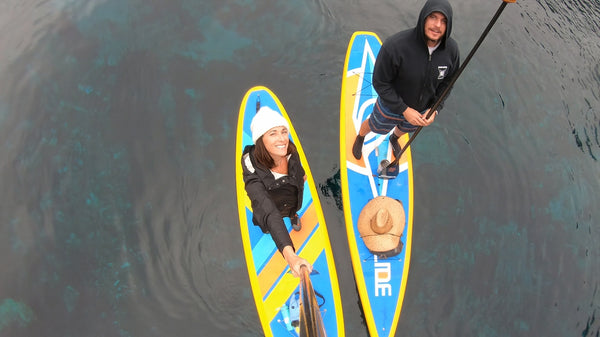
The Science Behind Paddle Board Stability and Balance
Balance is the name of the game when you are on a paddle board. We cover all of the ins and outs of balance and stability.
The Science Behind Paddle Board Stability and Balance
Paddle boarding is a popular water sport that requires balance, stability, and coordination. Understanding the science behind paddle board stability and balance can help you improve your skills and enjoy the activity to its fullest. In this article, we will explore the factors that contribute to paddle board stability and balance, including board design, paddling techniques, and the role of your body in maintaining equilibrium.
Stand Up Paddle Board Design and Stability

Paddle Board Width
One of the most critical factors in paddle board stability is the width of the board. A wider board provides a larger surface area, which translates to better balance and stability for the paddler (source). However, wider boards can also be slower and less maneuverable, so it's essential to strike a balance between stability and performance when choosing a board.
Paddle Board Thickness
The thickness of a paddle board also plays a role in stability. Thicker boards have more volume and buoyancy, making them more stable and better suited for beginners or heavier riders (source). On the other hand, thinner boards are generally faster and more responsive but may be less stable, making them better suited for experienced paddlers.
Paddle Board Shape
The shape of a paddle board can also influence its stability. Boards with a rounded nose are generally more stable than those with a pointed nose, as the rounded shape helps to disperse the force of waves and choppy water (source). Additionally, the tail shape can impact the board's maneuverability and stability, with wider tails providing more stability and narrower tails allowing for quicker turns.
Paddling Techniques and Stability
Paddle Stroke
The way you paddle can significantly impact your balance and stability on a paddle board. Proper paddle technique involves engaging your core muscles and maintaining a slight bend in your knees, which can help to improve stability and reduce the risk of falling (source). Additionally, keeping your paddle strokes smooth and consistent can help maintain balance and prevent sudden shifts in weight that could cause instability.
Paddle Length
The length of your paddle can also affect stability on a paddle board. A paddle that is too long can make it difficult to maintain proper form, while a paddle that is too short can force you to hunch over, compromising your balance (source).
The Role of Your Body in Maintaining Balance

Core Strength
Your core muscles play a crucial role in maintaining balance and stability on a paddle board. Engaging your core while paddling helps to stabilize your body and prevent wobbling or tipping (source). Incorporating core-strengthening exercises into your fitness routine can significantly improve your paddle boarding performance and stability.
Lower Body Stability
In addition to core strength, the stability of your lower body is critical for maintaining balance on a paddle board. Keeping a slight bend in your knees helps to absorb any movement in the water and allows you to adjust your weight more easily, enhancing stability (source).
Focus and Breathing
Maintaining focus and controlling your breathing are essential aspects of paddle board balance. Concentrating on a point in the distance can help you maintain balance, while deep, controlled breaths can help relax your body and reduce muscle tension (source). Practicing mindfulness and meditation techniques can also improve your focus and body awareness while paddle boarding.
Tips for Improving Stability and Balance on Stand Up Paddle Boards
Start in Calm Water
When learning to paddle board or working on improving your balance, it's best to start in calm, flat water. This will allow you to focus on your technique and build confidence without the added challenge of waves or choppy water (source).
Use a Leash and PFD
Safety should always be a priority when paddle boarding. Using a leash ensures that your board stays close if you fall, making it easier to regain your balance and get back on the board (source). Additionally, wearing a personal flotation device (PFD) can provide added buoyancy, making it easier to maintain stability in the water.
Practice Makes Perfect

Improving your paddle board balance and stability takes time and practice. Be patient with yourself, and don't be discouraged by setbacks. Regularly practicing your paddle boarding skills and incorporating balance exercises into your fitness routine can help you become more confident and stable on the water (source).
In conclusion, understanding the science behind paddle board stability and balance can significantly improve your paddle boarding experience. By considering factors such as board design, paddling techniques, and the role of your body in maintaining equilibrium, you can enhance your stability, enjoy the sport more, and reduce the risk of falls and injuries.


